You may not find this terribly rewarding unless you're included here, so this is a good time for casual and random browsers to turn back before they get too caught up in the sweep and majesty of the proceedings and can't let go.
Another fine day, and we're off to see the famous birthplace of the Montefeltro legacy.

San Leo, the "impregnable fortress town" of the Montefeltro lands, lies in the region of Emilia-Romagna, province of Rimini, adjacent to the border with the Marche region -- it's not much more than 10km as the crow flies from our digs in Montegiardino in San Marino, but it's taking us the better part of an hour on these roads because we're not crows.

A backward glance from a speeding little Volvo at San Marino to the northeast. [About the regional borders, San Leo was in the Marche region until a referendum in 2006 shifted it over to Emilia-Romagna.]

That's the Rocca of San Leo. The village, at about 640m altitude at its high point, is surrounded by serious cliffs all the way round, so from pre-Roman and Roman times it was strategically important; the Romans had a fortification here and, apparently, a temple to Jupiter Feretrio, and the site was thus called Mons Feretus, which morphed over time to Montefeltro.
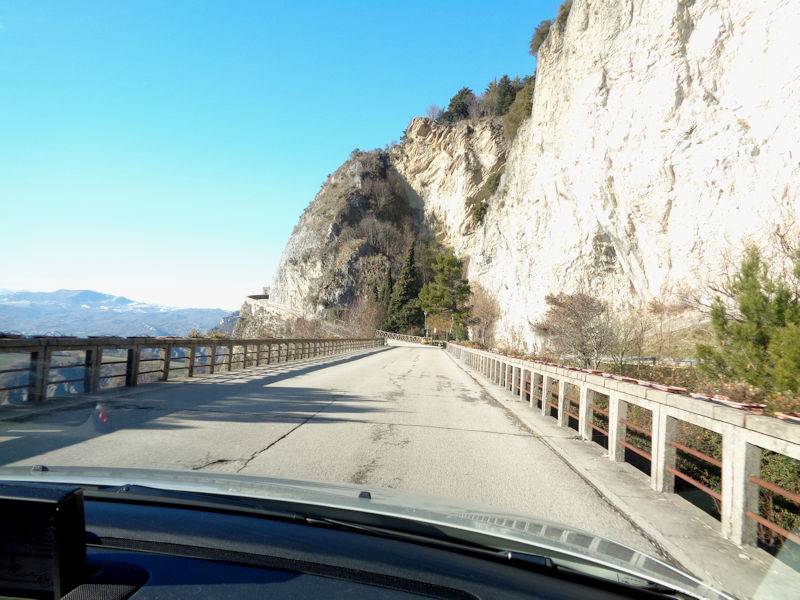
There is only one way up into the village of San Leo, and we're on it. Christianity came to the region, we're told, with San Leo, or Leone, a Dalmatian stonecutter working in Rimini in the 3rd or 4th century with his friend Marino, and they set out for the hills perhaps to Christianize everybody. Marino founded San Marino, and Leo settled here. The name of the village was changed from Montefeltro to San Leo in the fullness of time.

It's a good thing they've put this road in. The strategic values of the site, cliffs all round, water sources on top, and fertile ground as well, made it a highly contested location during the Gothic Wars (called Castrum Monteferetron at the time) and Lombard period, until in the 750s Pepin of the Franks included it in his gift of lands to the papacy. In the unsettled 10th century, San Leo served as the 'capital' of Italy, sort of, as the self-declared King of Italy since 950, Berenger II of Ivrea, got himself and family besieged here for two years in 962-63 by the forces of the newly-crowned Holy Roman Emperor, Otto I 'the Great' of Saxony, and had to surrender.

That, on the road ahead, is the only gateway into the town. At some time in the 11th century the Counts of Montecopiolo, a nearby hilltop castle that's presently an archaeological site, inherited the village of Montefeltro and took that name for their family, being confirmed as Counts of Montefeltro by the short-term Emperor Otto IV in 1210. The Montefeltro name, by the 9th century, had been applied to the whole diocese that was based in the cathedral here, whilst at about the same time the name of the village became accepted as 'San Leo' in honor the saint's relics.

Through the Porta di Sopra to the Via Montefeltro, the only serious road in town

The charming, single street in town. The present city hall, in the centre, is in the Palazzo Della Rovere, named for the family that moved in in the early 17th century as the new Dukes of Urbino.
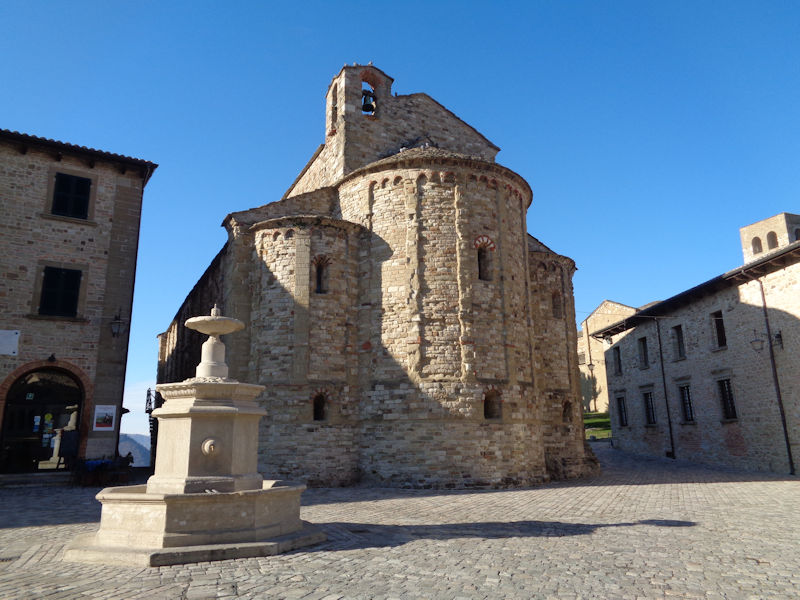
The apse of the Romanesque Pieve of Santa Maria Assunta, dating from the 9th century or earlier, in the Piazza Dante Alighieri; yes, Dante was here in 1306, and mentions the place in his Purgatorio; in fact, St Francis was here in 1213.

The Rocca di San Leo from the Piazza Dante -- by the 13th century, the Malatesta lords of Rimini had moved in, and the foundations of the present fortress mostly date from their time, but the Renaissance look comes from the thorough overhaul it was given in the 1470s by Federico da Montefeltro and his military architect Francesco di Giorgio Martini.

The Cattedrale di San Leone, or Duomo of San Leo, just off the main square

A single nave with two aisles and a raised presbytery built over the crypt. The present Lombard-Romanesque building was built over a very early predecessor and reconsecrated in 1173.

The episcopal diocese of Montefeltro was established in 785, only a few years after Charlemagne confirmed his dad Pepin's donation of the region to the papacy -- the first bishop whose name is known was Agatho, who resided in San Leo in 826.

There are all kinds of interesting things here, including two Roman columns, Romanesque carvings on the capitals of other columns, and "the first examples in Italy of acute arches".

Because the apse and altar must face to the east, there is no façade on the church -- the west end is virtually hanging out over the cliff. We enter through the side door.

Where a raised presbytery is really, really raised -- lest any churchgoers be able to see what the priests are up to around the altar.

The altar, and a copy of a crucifix donated by the Count of Montefeltro in 1205.

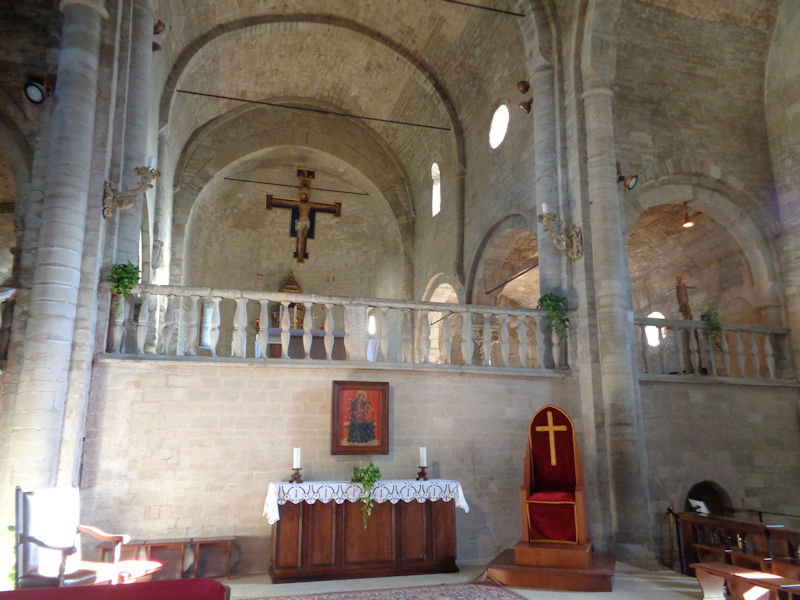
Below the chancel or presbytery is a painting of the Madonna and Child attributed to Catarino Veneziano, dated to 1375.
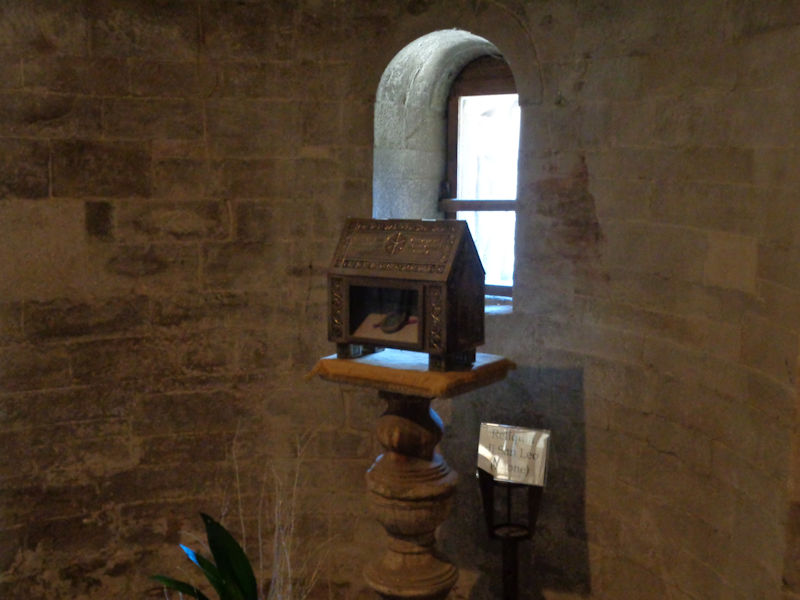
Down in the crypt, that reliquary purports to house relics of San Leo, but San Leo's remains are also said to have been carried off from the Pieve next door by the Emperor Henry II in 1014 either 1) to Voghenza near Ferrara, or 2) back to Germany where he lost them. But the sarcophagus cover is here in the duomo . . .

. . . over there.

A little altar in the crypt

Back into the sunlight

The belltower, on its rock out the back of the church, was originally a defensive watchtower later pressed into service for the bells. It's said to have a quadrilateral shell with a cylindrical spiral within. Closed at the moment.

We're walking out the dead-end street to the 'Belvedere' and panoramic look-out point.

Below, the river Marecchia 3km down the hill to the northwest

Next stop, the Romanesque Pieve of Santa Maria Assunta

The Pieve has the same problem with no façade on the west-facing end, so we enter through the side door.
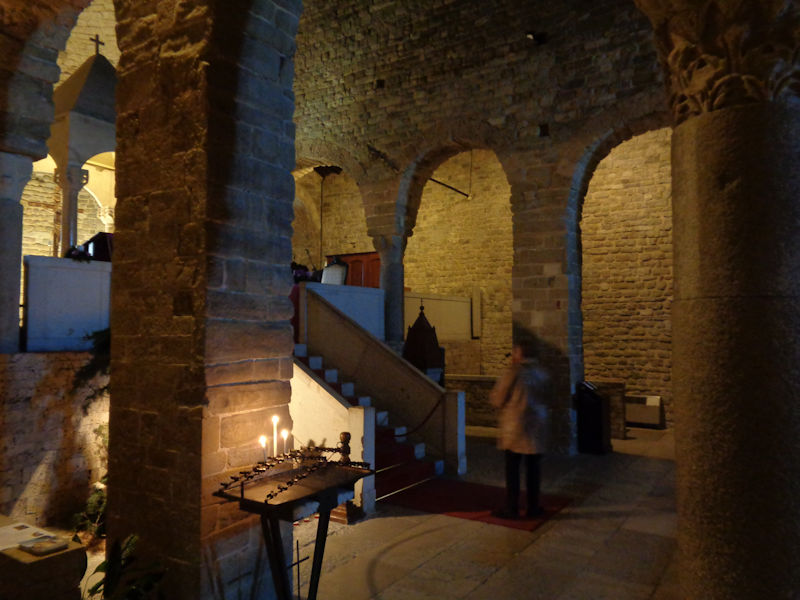
The wonderful Romanesque parish church

Another raised presbytery with a crypt underneath

The ciborium, or altar canopy, is described as the real original, donated to the church in 882 by 'Duke Orso', which is assumed to be the dating of the church itself.

Columns are where you find them.

Back to the Piazza Dante

The building at the end of the row on the right is the Palazzo Nardini, or Oratorio di San Francesco, a 13th century building with later Renaissance improvements. Traditionally, it was in a room on the second floor that in May 1213 St Francis, who was in town for the knighting ceremony for Montefeltrano II of Montefeltro, met the Count Orlando Cattani da Chiusi, who was so impressed by him that he donated secluded mountain lands for the order's Sanctuary of La Verna, where 11 years later Francis got his stigmata. [We tried to visit the Sanctuary of La Verna a few years ago, and only got this far.]

We're being summoned. Kristin's signaling from the Museo d'Arte Sacra, housed in the Palazza Mediceo, which was built by or for the Medicis during their very brief sojourn here 1517-1523. Pope Leo X Medici, desiring to help out his nephew Lorenzo II, son of Piero the Unfortunate who was thrown out of Florence in 1494, decided to make the 24-year-old syphilitic the Duke of Urbino in 1516, dispossessing the then-Duke Francesco Maria I della Rovere. In May 1517 the condottiere Antonio Ricasoli was hired to besiege the fortress of San Leo for the Papal/Medici cause, which brought about the fort's storming and surrender on 17 September 1517 -- the subject of Vasari's huge painting, the 'La presa della Fortezza di San Leo' now in the Palazzo Vecchio in Florence. Lorenzo died in 1519, Pope Leo in 1521, so Francesco Maria was able to reclaim his inheritance.
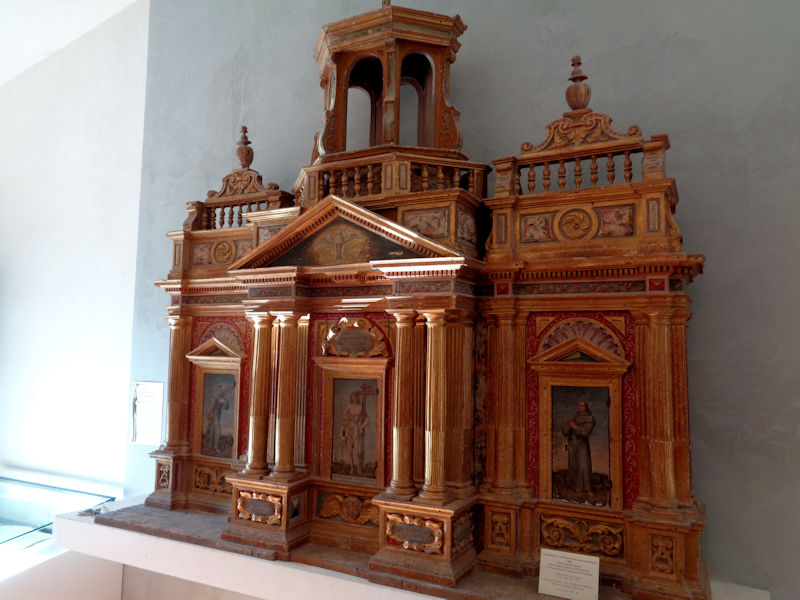
A beautiful tabernacle with pictures of St Francis and St Antonio of Padua, dated 1602

A 'Deposition' by Guercino and his workshop

The interior of the Museum of Sacred Art (with the Tourist Information Office downstairs)
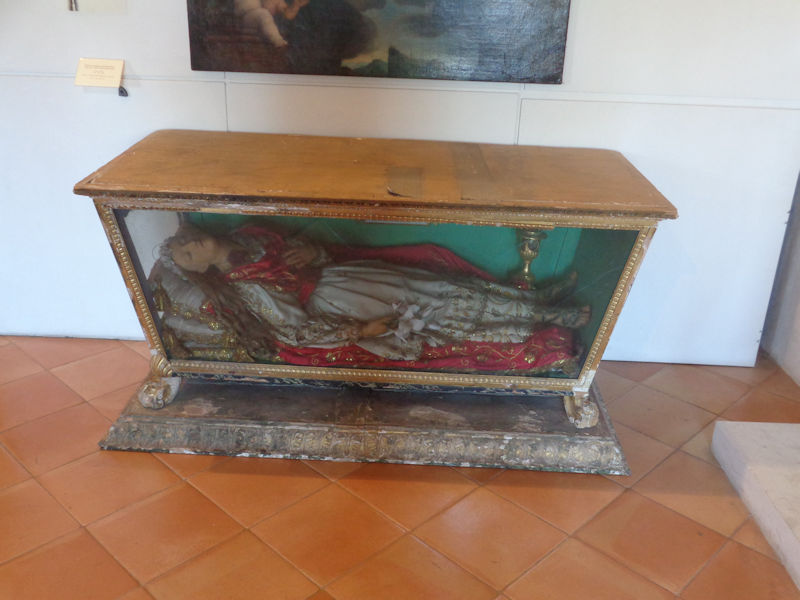
Somebody must know who this is, or was, but the label, if that's what it is, was just out of my line of sight.

A framed photo of San Leo
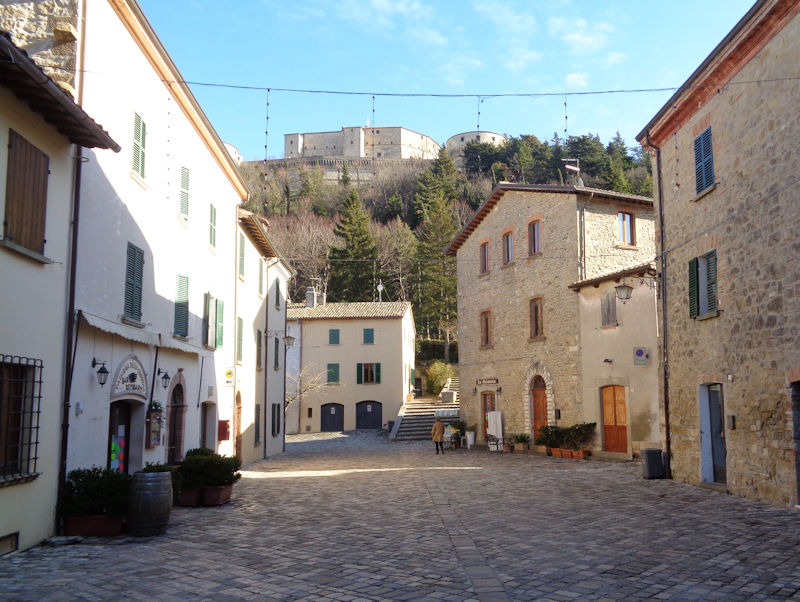
There's a road up the hill to the fortezza, but it's accessible only by the municipality's shuttle bus, which left at noon, or would have if anyone had been here, but it didn't because there wasn't anyone here (we were in the Duomo). So we get the more direct footpath straight up the hill.

The Fortezza or Rocca di San Leo. There had always been defensive fortifications on this hilltop, but the central residential block, later modified to Renaissance standards, was the core of the Malatesta era fortress of the late 14th and early 15th centuries.
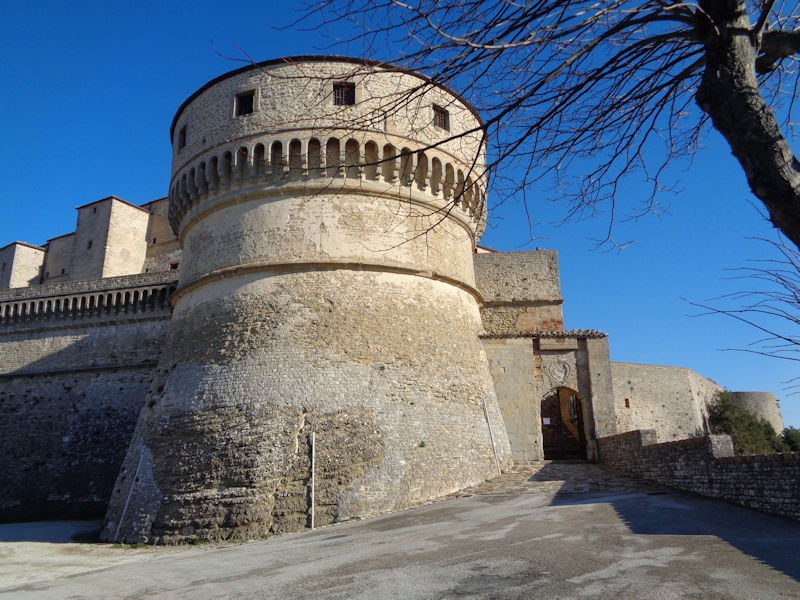
In 1441, however, the implacable enemy of the Malatestas, the Montefeltros, attacked and captured the fort -- an assault force led by the 19-year-old Federico da Montefeltro III (who had already been fighting for three years in the employ of the mercenary commander Niccolò Piccinino), illegitimate son of Guidantonio, Count of Urbino, saw off the Malatesta garrison and held onto San Leo for the rest of Federico's life. Guidantonio died in 1443 and was succeeded by his legitimate son Oddantonio, who was created Duke of Urbino on his confirmation by the pope. Alas, he comported himself too lavishly and tried to gain Malatesta support against his critics, and oops! he was assassinated in July 1444 in the pre-Federico Ducal Palace in Urbino.

Federico succeeded to the lordship of Urbino, and 30 years later (1474) was confirmed by the Pope as its Duke. The clever strategy for assaulting the fortress in 1441 was, since the town's defenses were weakest where the surrounding cliffs were the most daunting, for someone to scale the cliffs and open the town gate. Legend has it that Federico did the job himself, but in any case somebody did it and it was his idea.
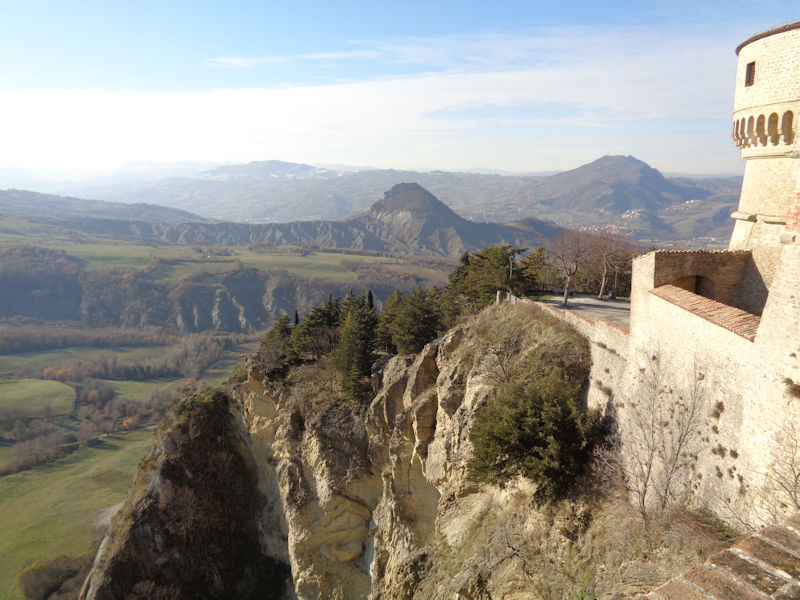
Surrounding countryside in the Marche and Emilia-Romagna. It's said that virtually every one of these hilltops has got ancient and medieval fortifications on top. Not all of them so well kept up as this one.

We're through the gatehouse and onto the 'first parade ground' (piazza d'armi) -- Federico was resident here from time to time (and, after 1460, with his devoted and learned wife Battista Sforza), but in the mid-1470s he employed the brilliant military engineer Francesco di Giorgio Martini to build new and upgrade existing fortifications to respond to changes in military technology, chiefly improved artillery. By Federico's death in 1482, Francesco had built nearly 70 fortifications for the Montefeltros and written the foremost treatise on military architecture of the time.
Now we proceed through that little gateway farther up to the 'second parade ground'.

This is the second parade ground, with the renovated residential block.

Martini's innovations included broad, low flat artillery platforms and low, round towers capable of sustaining incoming artillery fire and remaining stable when using large artillery in defense. As seen in the first photo of the fort just above, the two round towers can each cover half the wall between them with cannon and small-arms fire and can move cannons around within and on top of them to direct fire where it's needed. The projecting round towers are seen as offensive elements to complement the defensive functions of the walls. The walls are corbelled to permit small arms fire (and hot oil, etc.) to the base of the walls. Elsewhere, Martini is credited with a very early use of the star-shaped fortress design, the trace Italienne which dominated in Europe from the early 16th century into the 19th.

Within the larger tower, over the main gate, there is a museum dedicated to the fortress and the technology illustrated here.

A maquette of the San Leo Rocca

The eastern dead-end of the 'second parade ground', outside the main tower, and the residential medieval portion of the fort.

San Marino on yonder hilltop

The plan of the Rocca di San Leo, with the medieval core in grey and the Montefeltro Renaissance additions in color.

A representation of Federico da Montefeltro, in a pose based on the Piero della Francesa portrait. The castle museum has several rooms dedicated to the Malatesta and Montefeltro families, their genealogies, and their violent rivalries.

Moving along -- Count Alessandro di Cagliostro (real name: Joe Balsamo, 1743-1795) was a con man, adventurer, occultist and psychic healer, alchemist and magician, and master forger who somehow got involved in Marie Antoinette's Diamond Necklace Affair in 1785 (but was acquitted), and then in 1789 was convicted of Freemasonry by the Papal Inquisition, imprisoned in the Castel Sant'Angelo in Rome but when he attempted to escape, sent here -- a place already known as the papal prison you really did not want to end up in, the prison of last resort. That's his first cell.

The mouse droppings on the floor of Cagliostro's Cell are good luck coins wishful people have thrown in, as down a well or into a fountain. It appears that he was later moved to more commodious digs in the prison wing, but died after a few years here anyway.
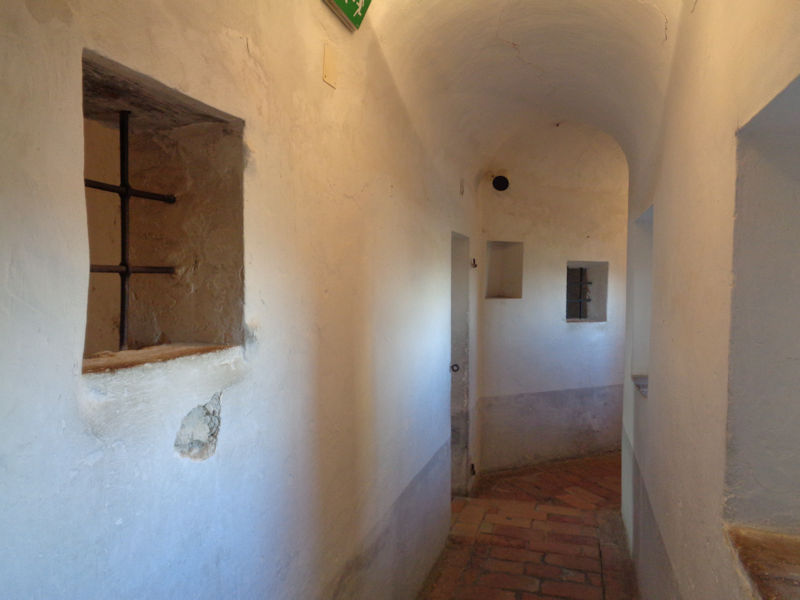
A corridor of cells in the papal prison wing of the castle

On top floor of the residential part of the castle, there is a museum of small arms, quite impressive and probably good fun for people who like that sort of thing.
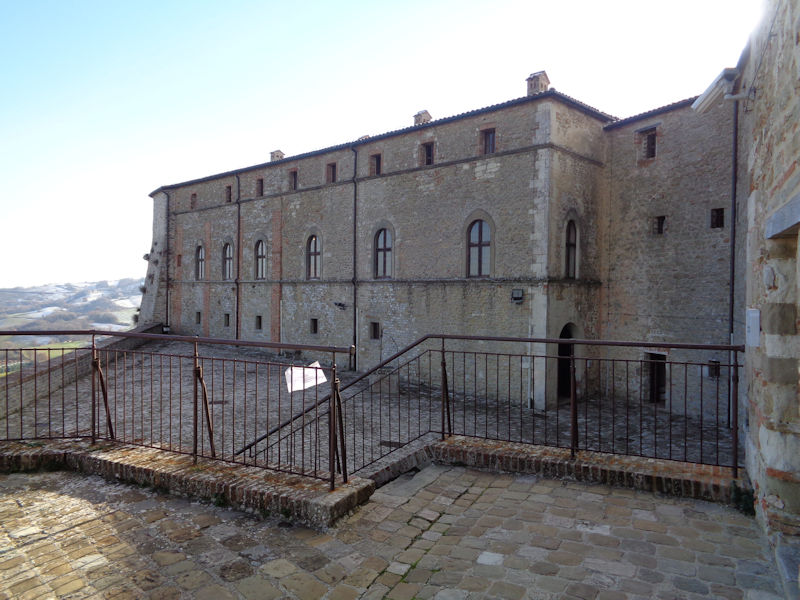
Out of the prison wing and staring down at the 'third parade ground', with the ducal residence on the ground floor across the way.

The use of the castle as a prison was perhaps most notorious during the 19th century resistance against the papal and Austrian tyrannies, during the time of the Risorgimento.

This cell is known as the home of Felice Orsini, a patriot from near Cesena a ways to the north, one of the Charcoal Burners movement who was arrested in Pesaro in 1844 and spent five months here along with other resistance fellows from Rimini. Once released, he went on to try to assassinate the Emperor Napoleon III in Paris in 1858 and got beheaded.
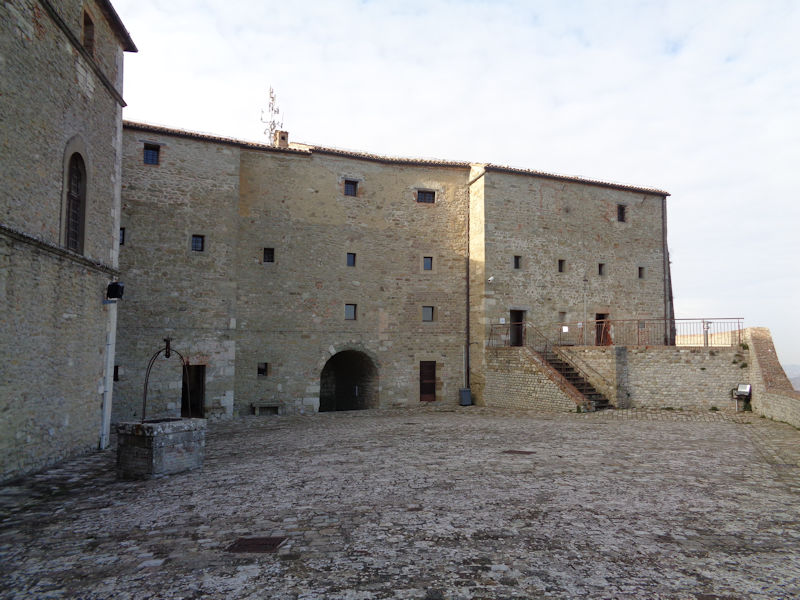
The third parade ground from the other direction
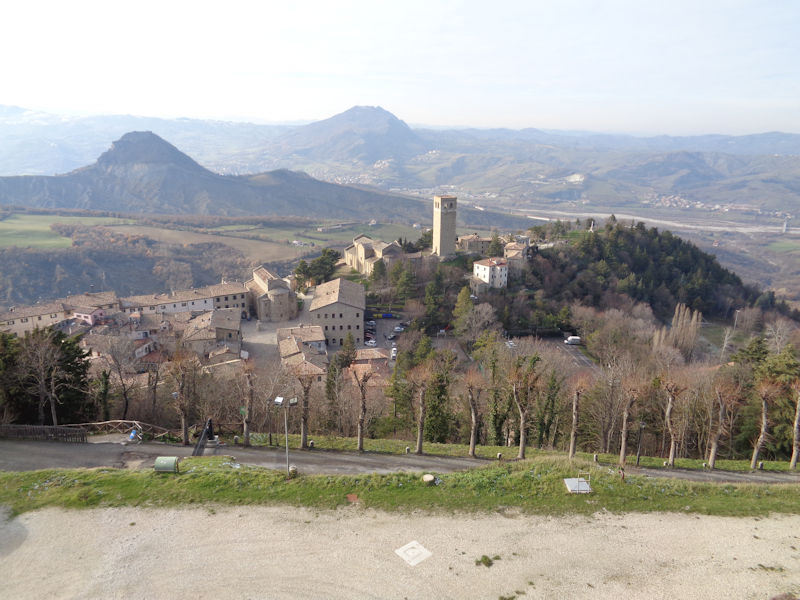
The town of San Leo below us -- we're starting back down the hill now.

The main tower and the car park below . . .

. . . with incongruous 20th century weapons on display.

And back out of the beautiful town of San Leo
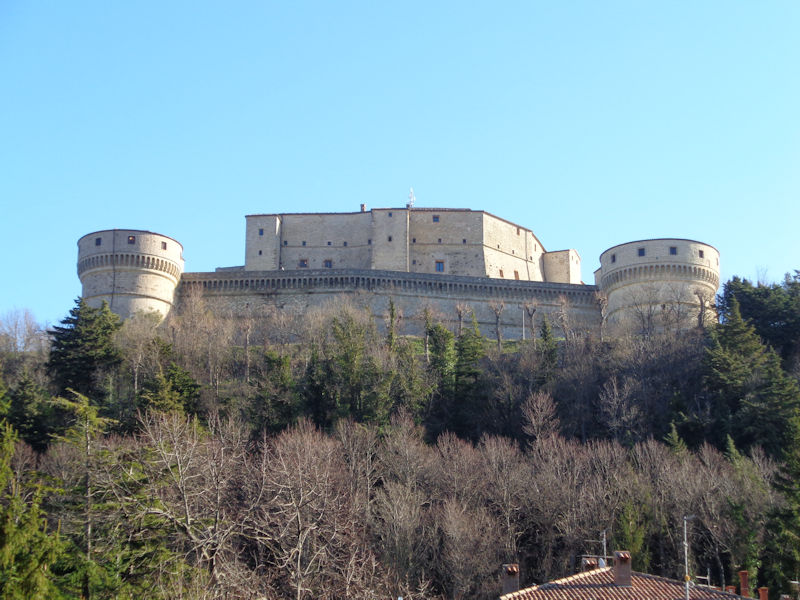
The Rocca di San Leo. Following the death of Federico da Montefeltro's son Guidobaldo in 1508, the Duchy of Urbino passed to the family of Federico's daughter Giovanna's son, Francesco Maria I della Rovere, and when that line played out in 1631 the whole thing reverted to the papacy. Which put San Leo to good use -- as a famous prison.
Next: Back to San Marino

 Dwight Peck's personal website
Dwight Peck's personal website
















































































